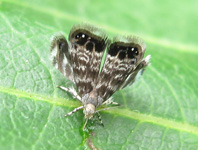Abstract
Brenthia yangi sp. nov. and its immature stages are described. The host plants of the new species are Grewia biloba G. Don and its variety parviflora Hand. -Mazz (Malvaceae). The preference for the position of escape holes in the larvae of the new species is revealed by statistical analysis. Larvae of I–II instar have no significant preference for the position of escape holes, whereas larvae of III−V instar significantly prefer to set escape holes along main veins. The size of silken pillar determines the position of escape holes in III−V instar larvae. The corner of two veins is not always the most preferred position for III−V instar larvae.
References
Aiello, A. & Solis, M.A. (2003) Defense mechanisms in Pyralidae and Choreutidae: fecal stalactites and escape holes, with remarks about cocoons, camouflage and aposematism. Journal of the Lepidopterists' Society, 57 (3), 168−175.
APG (2009) An update of the Angiosperm Phylogeny Group classification for the orders and families of flowering plants: APG III. Botanical Journal of the Linnean Society, 161, 105−121.
http://dx.doi.org/10.1111/j.1095-8339.2009.00996.x
Arita, Y. (1971) Genus Brenthia (Lepidoptera: Glyphipterygidae) of Japan. Kontyû, 39 (4), 346−352.
Arita, Y. (1987a) Brenthiinae (Lepidoptera: Choreutidae) of Thailand. Microlepidoptera of Thailand, 1, 7−55.
Arita, Y. (1987b) Taxonomic studies of the Glyphipterigidae and Choreutidae (Lepidoptera) of Japan. Transactions of the Shikoku Entomological Society, 18 (1−2), 1−244.
Budashkin, Y.I. & Li, H.H. (2009) Study on Chinese Acrolepiidae and Choreutidae (Insecta: Lepidoptera). SHILAP Revista de Lepidopterología, 37 (146), 179−189.
Chambers, V. (1878) Microlepidoptera. The Canadian Entomologist, 10, 74−78.
Clemens, B. (1860) Contributions to American Lepidopterology. No. 4. Proceedings of the Academy of Natural Sciences of Philadelphia, 12, 156−174.
Clarke, J.F.G. (1969) Glyphipterigidae. In: Clarke, J.F.G. (Ed.), Catalogue of the type specimens of Microlepidoptera in the British Museum (Natural History) described by Edward Meyrick. British Museum (Natural History), London, 6, pp. 24−39.
Diakonoff, A. (1986) Glyphipterigidae auctorum sensu lato (Glyphipterygidae sensu Meyrick, 1913), containing: Tortricidae: Hilarographini, Choreutidae, Brachodidae (partim), Immidae and Glyphipterigidae. In: Amsel, H.G., Gregor, F., Reisser, H. & Roesler, R.-U. (Eds.), Microlepidoptera Palaearctica. Vol. 7. Braun, Karlsruhe, pp. 1−466, pls. 1−175.
Heppner, J. & Duckworth, D. (1981) Classification of the Superfamily Sesioidea (Lepidoptera: Ditrysia). Smithsonian Contributions to Zoology, 314, 1−144.
http://dx.doi.org/10.5479/si.00810282.314
Hinton, H. (1946) On the homology and nomenclature of the setae of lepidopterous larvae, with some notes on the phylogeny of the Lepidoptera. Transactions of the Royal Entomological Society of London, 97 (1), 1−37.
http://dx.doi.org/10.1111/j.1365-2311.1946.tb00372.x
Li, H. (2002) The Gelechiidae of China (I) (Lepidoptera: Gelechioidea). Nankai University Press, Tianjin, 504 pp. [in Chinese]
Robinson, G.S., Ackery, P.R., Kitching, I.J., Beccaloni, G.W. & Hernández, L.M. (2010) HOSTS - A database of the world’s Lepidopteran hostplants, Natural History Museum, London. Available from: http://www.nhm.ac.uk/hosts (accessed 12 August 2014)
Rota, J. (2008) Immature stages of metalmark moths from the genus Brenthia Clemens (Choreutidae): Morphology and life history notes. Journal of the Lepidopterists’ Society, 62 (3), 121−129.
Rota, J. & Wagner, D.L. (2008) Wormholes, sensory nets and hypertrophied tactile setae: the extraordinary defence strategies of Brenthia caterpillars. Animal Behaviour, 76 (5), 1709−1713.
http://dx.doi.org/10.1016/j.anbehav.2008.06.024
Sidhu, A.K., Kaur, A. & Rose, H.S. (2012) Life history and chaetotaxy of Brenthia luminifera Meyrick (Microlepidoptera: Choreutidae: Brenthinae [sic]). Environment and Ecology, 30 (3B), 1005−1010.
Williams, J. (1951) The bionomics and morphology of Brenthia leptocosma Meyrick (Lep., Glyphipterygidae [sic]). Bulletin of Entomological Research, 41 (3), 629−635.
http://dx.doi.org/10.1017/s0007485300027887
Yang, J. (1977) Moths of North China. Vol. 1. Agricultural University of North China, Beijing, 299 pp.
Zimmerman, E.C. (1978) The immature stages of Lepidoptera. In: Zimmerman, E.C. (Ed.), Insects of Hawaii. Vol. 9. Microlepidoptera. Part I. The University Press of Hawaii, Honolulu, pp. 109−200.

